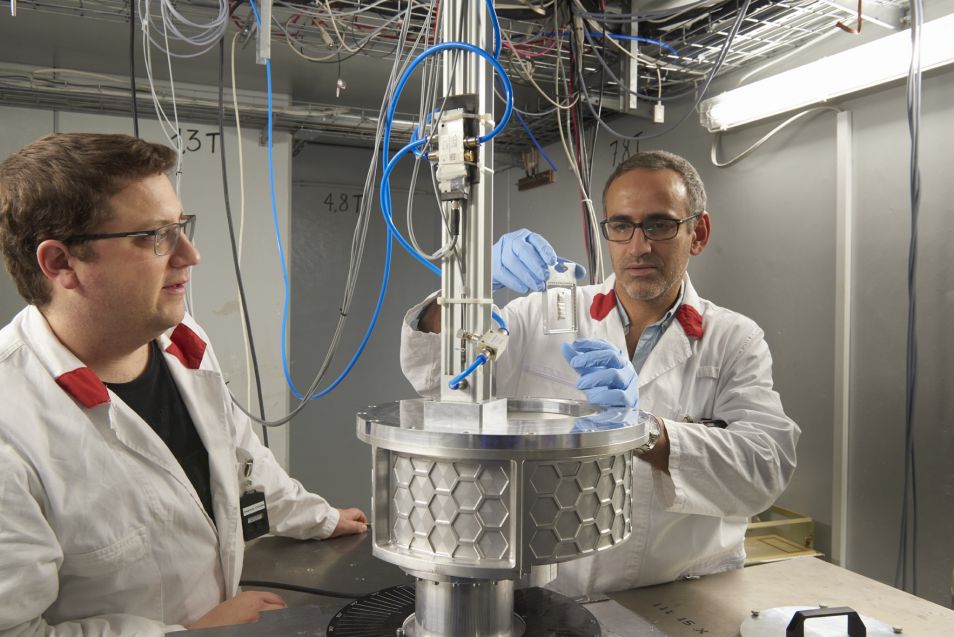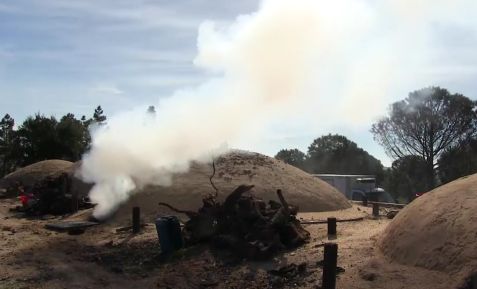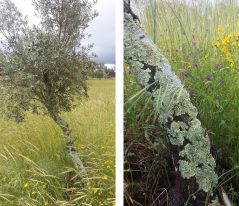MLZ is a cooperation between:
 > Technische Universität München
> Technische Universität München > Helmholtz-Zentrum Hereon
> Helmholtz-Zentrum Hereon
 > Forschungszentrum Jülich
> Forschungszentrum Jülich
MLZ is a member of:
 > LENS
> LENS > ERF-AISBL
> ERF-AISBL
MLZ on social media:

MLZ (eng)
Lichtenbergstr.1
85748 Garching
Bad air: Tracking down pollution with neutrons

Dr. Nuno Canha analysing his lichens using neutrons at the Prompt Gamma Activation Analysis with Dr. Christian Stieghorst. © W. Schürmann / TUM
This smell of burned wood is familiar to Nuno Canha since his childhood. Especially in winter, when the cold is higher, besides the usual smoke from wood burning for house heating, an additional air pollution source is active. It promotes intense smoke and a characteristic smell in some small rural villages in Portugal: traditional charcoal furnaces.
The municipality of the region of Alto Alentejo from where Nuno Canha is native is the Portuguese municipality with a higher number of this traditional and small-scale industry that is based on ancient techniques. One small village gathers around 100 stoves. According to Nuno Canha with a PhD in environmental sciences, smell complaints and reports of asthma and other respiratory diseases are not uncommon among the inhabitants of this village.
The charcoal ovens guarantee employment
However, monitoring of air quality is not common in the Portuguese inland, but rather in the main cities in the coast region. Besides that, taking in account that this activity has a big influence in the local economy and employment, this is a sensible issue to the authorities. Nuno Canha says, that it is even hard to obtain collaboration with the charcoal producers to understand what is the real impact of this type of industry on the local air quality and how to overcome the potential problems.
Nuno Canha, 36-year-old, working at the Instituto Superior Técnico from University of Lisbon and at University of Aveiro, wanted to find an indirect way to evaluate the impact of this industry into the air quality that could be affordable, easy to perform and that did not disturb the population. The chosen strategy was biomonitoring of native lichens.
Lichens absorb nutrients from the air
Lichens are a symbiosis of fungi and algae and, since “because they absorb all their nutrients through the air, they are a great indicator of air quality” says Nuno Canha. He designed a grid over the study area, with the area of the wood-coal stoves included, and collected the lichens “Flavoparmelia caperata (L.) Hale” from the trunks of olive trees. He picked one batch in the spring, the other in the fall, to rule out seasonal differences.
So far, the electrical conductivity has already been measured on the lichens: the higher the conductivity of the lichens in a water bath, the more likely stress was assumed due to the exposure of the organisms to higher levels of air pollution. As the fine cell membranes break under extreme stress, this in turn has a positive effect on the conductivity of the lichens. Preliminary results confirm that higher values of electric conductivity are found nearby the charcoal furnaces.
Nuno Canha has also used neutrons to study lichens for his doctoral thesis, with neutron activation analysis (NAA). “Back then, I was using lichens hung in the indoors and outdoors of classrooms to study whether the air in elementary schools is better in the countryside or in the city,” says Nuno Canha. Why this solution and not the usual monitoring equipment of air quality? It was a noiseless solution, without interfering on the activities of the classes, easy to handle and not too expensive.
More potassium and sulfur in the affected lichens

The traditional charcoal ovens obviously produce smoke. © André Moreira / visao
New is now the Prompt Gamma Activation Analysis (PGAA). At the PGAA of the Heinz Maier-Leibnitz Zentrum in Garching with Dr. Zsolt Revay and Dr. Christian Stieghorst, the environmental scientist can measure several elements in the freeze-dried lichens. “The PGAA is much better for the lighter elements than the NAA,” explains Nuno Canha. These are, for example, N, S, Si, P, O, C, F, Cl and H, besides some other elements, such as K. Above all, potassium and sulfur are found in higher concentrations in the lichens near the charcoal furnaces. Some of the “fingerprints” of burning wood are exactly sulfur dioxide and potassium. This fits well with the conductivity measurements, which attest the higher stress of the lichens that are nearby the furnaces, confirming the air pollution in these sites, when comparing with sites without those furnaces.
Nuno Canha will soon present his results at a conference and then publish them. He hopes that this new information will change things in his hometown and that the traditional charcoal production gets more attention from the authorities and efforts are made to improve the environmental performance of this industry, such as air filters that remove the pollutants from the exhaust.
“The charcoal furnaces have become more and more in recent years, but the economic development should not overcome the persons’ health and welfare, along the air quality that people breathe. As the United Nations and World Health Organization stand out: clean air is a human right”, he says.

Andrea Voit
Press & Public Relations
FRM II
MLZ is a cooperation between:
 > Technische Universität München
> Technische Universität München > Helmholtz-Zentrum Hereon
> Helmholtz-Zentrum Hereon
 > Forschungszentrum Jülich
> Forschungszentrum Jülich
MLZ is a member of:
 > LENS
> LENS > ERF-AISBL
> ERF-AISBL
MLZ on social media:



